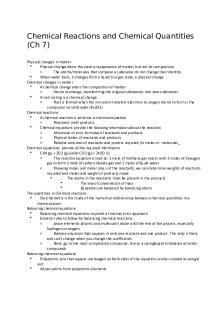Predicting products of chemical reactions PDF

| Title | Predicting products of chemical reactions |
|---|---|
| Course | General Chemistry |
| Institution | Queen's University |
| Pages | 3 |
| File Size | 141.6 KB |
| File Type | |
| Total Downloads | 42 |
| Total Views | 133 |
Summary
Summary of predicting products of chemical reactions....
Description
Predicting Compounds SYNTHESIS
- Two or more simpler substances (elements and/or compounds) come together to form a more complex one
A + B ➝ AB
HINTS
- There is only 1 product - Reactants are not solutions - Reactants are not 2 metals TYPES
- M/nm + oxygen ➝ (element name) oxide - M + nm ➝ binary compound - Metal oxide + water ➝ metal hydroxide - Metal oxide + carbon dioxide ➝ metal carbonate - Nonmetal oxide + water ➝ nonmetal oxyacid (make the polyatomic ion, then add hydrogens in front)
(Change name of the polyatomic ion ~ ending “ate” to “ic”)
DECOMPOSITION
- Large molecules split into elements or smaller molecules
AB ➝ A + B
HINTS
- There is only 1 reactant - The only 1 reactant is a compound TYPES
- Binary compound ➝ M + nm - Metal carbonate ➝ (metal name) oxide + carbon dioxide - Metal hydrogen carbonate ➝ metal carbonate + water + carbon dioxide - Metal chlorates ➝ metal chloride + oxygen gas
SINGLE DISPLACEMENT
- One element replaces another element that is in a compound HINTS
A + BC ➝ AC + B A is a metal
- There are two reactants, one of them is an element KEY A + BC ➝ BA + C
- Metals replace metals
A is a nonmetal
- Nonmetals replace nonmetals - Metals replace hydrogen in an acid
DOUBLE DISPLACEMENT
- The cations of 2 different compounds switch places HINTS
- Two reactants and two products
AB + CD ➝ AD + CB
- Both reactants are ionic compounds - Reactants are usually aqueous KEY
- Use solubility table to determine which is precipitate of reaction
TYPES - Metal carbonate + acid ➝ salt + water+ carbon dioxide (combine metal and nonmetal)
COMBUSTION OF ORGANIC COMPOUNDS
- Organic compounds burn in oxygen HINTS
- The only two products are carbon dioxide and water - There is a Delta triangle on top of the reaction arrow...
Similar Free PDFs

Rates of Chemical Reactions
- 9 Pages

Types of chemical reactions
- 4 Pages

Bill Nye Chemical Reactions
- 2 Pages

Chapter 15 Chemical Reactions
- 21 Pages

Chemical reactions equations
- 6 Pages

Balancing Chemical Reactions
- 4 Pages

Lab Experiment 4- Chemical Reactions
- 10 Pages
Popular Institutions
- Tinajero National High School - Annex
- Politeknik Caltex Riau
- Yokohama City University
- SGT University
- University of Al-Qadisiyah
- Divine Word College of Vigan
- Techniek College Rotterdam
- Universidade de Santiago
- Universiti Teknologi MARA Cawangan Johor Kampus Pasir Gudang
- Poltekkes Kemenkes Yogyakarta
- Baguio City National High School
- Colegio san marcos
- preparatoria uno
- Centro de Bachillerato Tecnológico Industrial y de Servicios No. 107
- Dalian Maritime University
- Quang Trung Secondary School
- Colegio Tecnológico en Informática
- Corporación Regional de Educación Superior
- Grupo CEDVA
- Dar Al Uloom University
- Centro de Estudios Preuniversitarios de la Universidad Nacional de Ingeniería
- 上智大学
- Aakash International School, Nuna Majara
- San Felipe Neri Catholic School
- Kang Chiao International School - New Taipei City
- Misamis Occidental National High School
- Institución Educativa Escuela Normal Juan Ladrilleros
- Kolehiyo ng Pantukan
- Batanes State College
- Instituto Continental
- Sekolah Menengah Kejuruan Kesehatan Kaltara (Tarakan)
- Colegio de La Inmaculada Concepcion - Cebu








